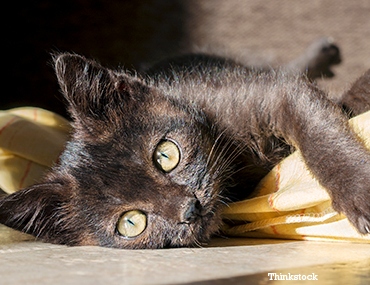
Are you thinking of adding a new kitty to your home? Congratulations!
However, if you have other cats at home, pay heed; before bringing your new kitten home to meet the others, make sure to talk with your veterinarian about the risks of calicivirus, and other upper respiratory infections (URIs) and the importance of isolating your new kitten from your other cats (typically for at least 5-7 days). I know it sounds tough, but it’s so you can protect your other cats at home.
Cats can easily transmit URIs, like calicivirus. URIs are the human equivalent of the common cold. Calicivirus and other feline URIs are highly contagious infections that can result in mild to severe clinical signs (especially in immunosuppressed or very young kittens). Causes for URIs in cats, besides calicivirus, include herpesvirus (FHV-1), Chlamydia, Mycoplasma, and Bordatella bronchiseptica (what causes kennel cough in dogs). Thankfully, none of these are transmissible to you.
Upper respiratory infections are more likely to occur under certain circumstances: crowded living conditions (e.g., shelters, catteries), unsanitary conditions (e.g., when poor disinfection or poor hygiene are allowed), or during times of exposure to affected cats where bodily fluids are being exchanged by contagious discharge from the eyes or nose (sneezing). I see calicivirus and URIs like it most often after a new kitten is introduced to the home – exposing the other cats; hence, my recommendation of quarantining new kittens for a few days. Your middle-aged or geriatric cat doesn’t want to deal with a cold!
Signs of calicivirus or other URIs include the following:
- Nasal discharge (typically clear colored but may progress to pus-colored)
- Sneezing
- Inappetance/anorexia

- Discharge from the eyes (typically clear colored but can progress to pus-colored)
- Squinting of the eyes (which may be due to ulcers of the cornea)
- Lethargy
- Difficulty chewing food (due to ulcers on the tongue and in the mouth)
- Drooling (due to ulcers on the tongue and in the mouth)
- Pink eye signs (e.g., redness of the eyes due to secondary inflammation of the conjunctiva)
- Ulcers in the mouth
- Noisy breathing
- Increased or difficulty breathing
- Dehydration
- Fever
- Death (rare)
Treatment of calicivirus
While there’s no cure for calicivirus or any URI (just like the common cold), there are some things you can do to help alleviate the severity of clinical signs:
- Keep discharge away from the eyes and nose by gently wiping it with a damp towel
- Take your cat into the bathroom with you (not in the shower) so the hot steam can help provide moisture to the nostrils
- Most importantly -- tempt your cat to eat -- if your cat can’t smell their food due to discharge from their nose, they won’t eat it. By using smelly, tasty canned food which you can microwave for a few seconds (not too hot!) you can help convince your cat to eat while feeling ill. Keep in mind that cats can only go about 4-5 days without eating before they can develop fatty changes to their liver (i.e., hepatic lipidosis).
- Another important recommendation is to minimize stress when your cat’s sick (e.g., don’t bring them for a weekend getaway in the car).
- Keep your cat indoors and away from other cats so he won’t spread calicivirus or any URI.
When in doubt about treatment, check with your veterinarian for an exam. (It's always best to give your veterinarian a call when you notice any changes in your cat's health or behavior.) Veterinarians may be able to give fluids (under the skin or intravenously, depending on how sick your cat is) to help hydrate your cat. Veterinarians can also offer some even tastier prescription cans of food. With moderate to severe cases of URIs, certain medications may be necessary.
Personally, I don’t jump to antibiotics to treat URIs because they are viral in origin, and antibiotics only help if there’s a secondary bacterial infection (antibiotics don’t work for viruses). Besides which, some antibiotics may lead your cat to become anorexic, which can worsen the problem. That said, if your cat has corneal ulcers secondary to any URIs, topical eye medications (e.g., terramycin, erythromycin, etc.) may be necessary. You and your veterinarian might also consider a supplement called lysine, which is often helpful with feline viral infections and is very benign. There are some anti-virals that can also be used both orally and topically in the eye, but these are pretty expensive and generally avoided.
What's the prognosis for calicivirus?
The prognosis for feline calicivirus and for other URIs is good with supportive care. Treatment by your veterinarian may be necessary, depending on the severity of clinical signs, so when in doubt, a veterinary exam is a must, and always recommended anyway when dealing with a new cat in your home. Make sure your new kitten or house cats are up to date on their vaccines because some vaccines help to lessen the severity of calicivirus and other URIs. Talk to your veterinarian about how frequently to vaccinate your cat(s) based on your cat's level of exposure. Don’t forget to check out the new kitten checklist!
If you have any questions or concerns, you should always visit or call your veterinarian -- they are your best resource to ensure the health and well-being of your pets.
